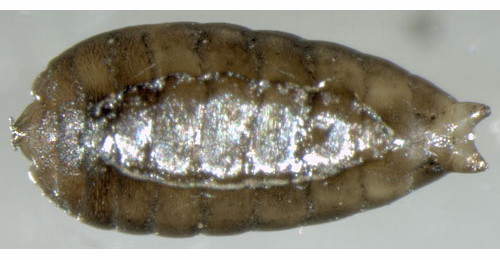|
||||||
|
Phytomyza
vitalbae Kaltenbach, 1872 Phytomyza
vitalbae Kaltenbach, 1872. Pflanzen-Feinde : 4 |
|||||||||||||||||||||||||||||||||||||||||||||||||||||||||||||||||||||||||||||||||||||||||||||||||||||||||
|
Leaf-miner: A long narrow upper surface mine. Pupation external (Spencer, 1972b: 70 (fig. 227), 73; Spencer, 1976: 525, 526 (fig. 920)). Oviposition in the leaf lower surface. After a short initial corridor of a few mm length the larva makes an upper-surface corridor that mostly begins with a dense knot in the leaf tip. Frass in long pearl chains along the sides. In fresh material primary feeding lines are apparent. Pupation outside the mine; exit slit in the lower epidermis. The mine often causes the leaf to be malformed and wrinkled. Feeding punctures in the lower surface (Bladmineerders van Europa). The larva forms a long narrow upper surface mine. Most mines start close to the leaf tip. The larva exits through a slit. Pupation is external (British leafminers). Larva: The larvae of flies are leg-less maggots without a head capsule (see examples). They never have thoracic or abdominal legs. They do not have chewing mouthparts, although they do have a characteristic cephalo-pharyngeal skeleton (see examples), usually visible internally through the body wall. The larva is described by de Meijere (1926). The larva is illustrated in (Bladmineerders van Europa). Puparium: The puparia of flies are formed within the hardened last larval skin or puparium and as a result sheaths enclosing head appendages, wings and legs are not visible externally (see examples). Pale brown; posterior spiracles each with an ellipse of 10 bulbs (Spencer, 1976: 525). The puparium is illustrated in (Bladmineerders van Europa).
Hosts in Great Britain and Ireland:
Hosts elsewhere:
Time of year - mines: June-September. Time of year - adults: Currently unknown. Distribution in Great Britain and Ireland: Widespread in S.E. England, also in S. Wales, Glamorgan (Gower peninsula) (Spencer, 1972b: 73), Hampshire (Noar Hill, Selbourne), Hertfordshire (British leafminers), Warwickshire (Coventry) (Robbins, 1991: 26); Caernarvonshire, Cambridgeshire, East Gloucestershire, Glamorgan, Leicestershire, Merionethshire, North Essex, North Somerset, Shropshire, South-west Yorkshire, West Gloucestershire and West Kent (NBN Atlas). Also recorded in the Republic of Ireland: Co. Cork (Glengariff), Dublin (Spencer, 1972b: 73) and National Biodiversity Data Centre Map). Distribution elsewhere: Widespread in continental Europe including Belgium (de Bruyn and von Tschirnhaus, 1991), Denmark, Sweden (Spencer, 1976: 525), The Netherlands (Bladmineerders van Europa), Germany (Spencer, 1976: 582), Corsica, Croatia, Czech Republic, Estonia, French mainland, Hungary, Italian mainland, Poland, Romania, Spanish mainland, Switzerland and Yugoslavia (Fauna Europaea). Also recorded in W. Australia (Spencer, 1990: 33). NBN Atlas links to known host species:
British and Irish Parasitoids in Britain and elsewhere:
|
| Last updated 10-Jul-2019 Brian Pitkin | ||

